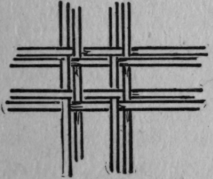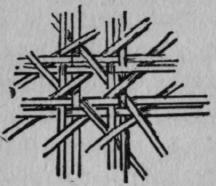Chapter II Chair Seating
Description
This section is from the "Handicrafts For The Handicapped" book, by Herbert J. Hall and Mertice M. C. Buck. Also available from Amazon: Handicrafts For The Handicapped.
Chapter II Chair Seating
a. Cane seating.
Humble industry, but always useful everywhere. Material, and its use. Illustration of steps in caning - various weaves. Binding, etc.
b. Rush seating.
Lucrative industry, known to but few, suitable for city or country workers. Preparation of rushes. Method of working, illustrated by sketches.
Twenty-five or thirty years ago there was in nearly every household some person who understood how to replace the worn-out seat in a "cane-bottom" chair. This useful art was gradually forgotten, but in the recent revival of interest in homely industries cane seating and rush seating have come again to the fore. The following directions, carefully followed, will give good results. Cane is the bark of a long, slender vine, the inside of which is the material which is called reed or rattan. The cane being removed, the rattan is put through a tubular cutter which makes it of the desired size. The cane is sold in bunches of a thousand threads. It comes in several sizes; coarse, medium, fine, and fine-fine being the most used. It is necessary also to have a few threads of what is called binding cane. In order to use it to the best advantage it should be soaked for a few minutes in warm water and then put to drain in a damp towel. The frame for practice may be purchased at a kindergarten supply store. It is like an empty slate frame, and an old-fashioned slate frame with the regular holes is equally good. It is necessary to have some small pegs to fit these holes to hold the cane in place. If the frame has an uneven number of holes the first line of cane should go from the center front hole to the center back hole. An end three inches long being pushed down through the front hole and pegged in place, the long piece of cane is then pushed down through the center back hole and pegged in place. The weaving then goes up through the next right-hand hole, each successive row being pegged with the pegs from the preceding row. The weaving is then done from the center to the left in the same way. The second process is the weaving across the frame, which is done in the same way, beginning at the center.
The third process is a series of vertical lines, over the first series. By this time there will be ends to fasten, which may be done by moistening each with a damp sponge, and wrapping it once around the nearest cane that goes between two holes, as may be seen by reference

Fastening Ends.
to a chair. The ends must be securely fastened, and the work should be done carefully. The pegs may be removed after the ends are fastened.
The next weave is the one which beginners usually find the most difficult, and care must be taken to avoid mistakes. The weaving should be done with the right hand, the left being kept under the work to guide the point of cane which should be sharpened occasionally.


Chair Caning
The work should go from right to left in this order: just below the top row, over an upper vertical, under a lower, across the top row, then thread the cane through the hole, bring it up in the next lower hole, and go back from left to right, just below the second row, the only difference being that the first weave is below the lower vertical instead of over the upper. The rows must form perfect little squares as shown in the sketch, which should be studied closely. When the frame is filled with this weave, the threads may be dampened and pushed with a peg so as to make the work perfectly regular.
The next step is called the oblique weave. It starts first from the lower left corner and goes over two horizontal threads and under two vertical, which will bring it out at the corner diagonally opposite to the one started from. The sketch shows the effect. When these rows are completed weave from the lower right corner to the upper left. When all the threads are completed there remains but the binding to be done. Put one end of binding cane, which must be well soaked in warm water, down through a corner hole and peg it well.
Then take a strip of very fine cane, and thread it up through a hole, over the binding cane, and down through the same hole. This is sometimes called couching, and is very important in holding a chair seat firmly in place. The process in caning a chair is exactly the same as in caning a frame, except that owing to the irregular shape of most chair frames new problems will continually arise to add to the interest of the work. In the first place it is well to try a chair that is approximately square-seated, and it is an excellent plan to have a similar one beside it for reference. The old cane must first be removed with a sharp knife, then every hole must be cleared out with an awl or a hammer and nail. It is an excellent plan to wash out the holes with weak carbolic, as disease germs lurk in just such places.

Binding Or Couching.
The cane used must correspond in size to that taken out. The work must begin in the center as already described. The steps are the same as in the frame, except that at the sides it may be necessary to skip some holes in order to make the rows an even distance apart. The horizontal rows are put in as usual, also the over and under, but in weaving the oblique rows the lines must be kept parallel, and this may necessitate putting two rows into one hole. On a round-seated chair this must be done many times. Sometimes there are places where it is necessary to drive in a wooden plug whittling it off flat, so that it will not interfere with the binding. In many chairs the binding is couched only in every other hole, in this case it must be put in every hole at the corners, as the security of the work depends largely on the binding.
Chair-caning is an excellent physical exercise and calls in play seldom-used muscles, but the worker should be warned against trying to work without a low box or foot-stool, and keeping at it too long at a time until the muscles are accustomed. It is work that gives great satisfaction, as care and patience give quick returns, and with a few weeks' practice it is possible to obtain results much superior to those seen in nine-tenths of the chairs done by "professionals."
Continue to:


